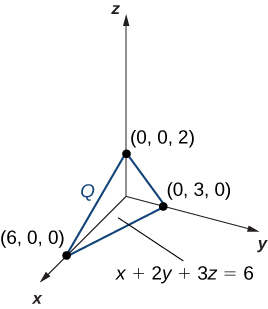| << Chapter < Page | Chapter >> Page > |
respectively. In each case, the radius of gyration tells us how far (perpendicular distance) from the axis of rotation the entire mass of an object might be concentrated. The moments of an object are useful for finding information on the balance and torque of the object about an axis, but radii of gyration are used to describe the distribution of mass around its centroidal axis. There are many applications in engineering and physics. Sometimes it is necessary to find the radius of gyration, as in the next example.
Consider the same triangular lamina with vertices and and with density as in previous examples. Find the radii of gyration with respect to the the and the origin.
If we compute the mass of this region we find that We found the moments of inertia of this lamina in [link] . From these data, the radii of gyration with respect to the and the origin are, respectively,
Use the same region from [link] and the density function Find the radii of gyration with respect to the the and the origin.
and
All the expressions of double integrals discussed so far can be modified to become triple integrals.
If we have a solid object with a density function at any point in space, then its mass is
Its moments about the the and the are
If the center of mass of the object is the point then
Also, if the solid object is homogeneous (with constant density), then the center of mass becomes the centroid of the solid. Finally, the moments of inertia about the the and the are
Suppose that is a solid region bounded by and the coordinate planes and has density Find the total mass.
The region is a tetrahedron ( [link] ) meeting the axes at the points and To find the limits of integration, let in the slanted plane Then for and find the projection of onto the which is bounded by the axes and the line Hence the mass is

Consider the same region ( [link] ), and use the density function Find the mass.
Suppose is a solid region bounded by the plane and the coordinate planes with density (see [link] ). Find the center of mass using decimal approximation.
We have used this tetrahedron before and know the limits of integration, so we can proceed to the computations right away. First, we need to find the moments about the the and the
Hence the center of mass is
The center of mass for the tetrahedron is the point

Notification Switch
Would you like to follow the 'Calculus volume 3' conversation and receive update notifications?